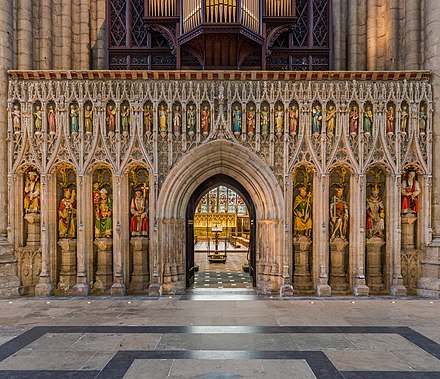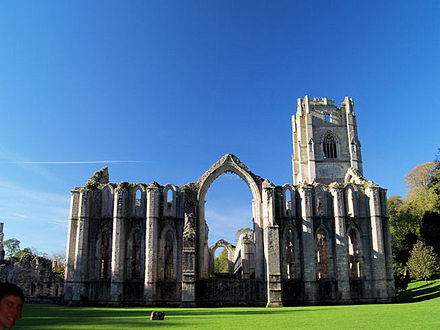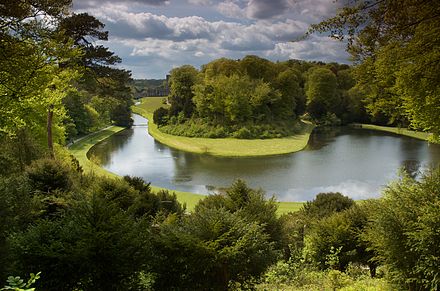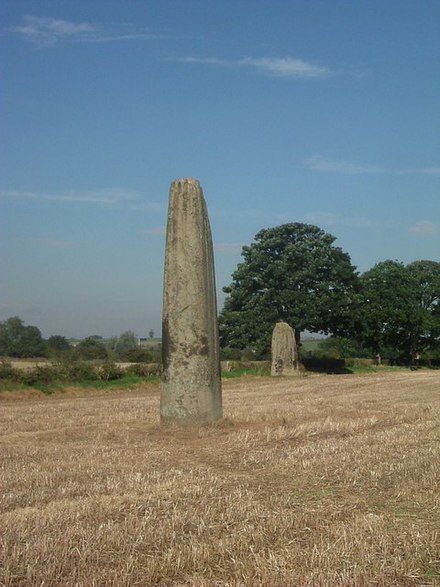Ripon is a cathedral city in North Yorkshire, England, with a population in 2011 of 16,702. Its main attraction is the cathedral, and the nearby UNESCO World Heritage Site of Fountains Abbey and Studley Royal Water Garden. It’s also a good base for exploring the Yorkshire Dales.
Understand
Sep2003.jpg/440px-NewbyHall(LynneGlazzard)Sep2003.jpg) Ripon has long been a religious centre. In 1132 thirteen monks were expelled from the Benedictine house in York (rioting, rowdiness, just the usual monastic peccadilloes). They found a new base in the valley of the little River Skell and affiliated to the Cistercians. Their abbey grew wealthy through wool, and they farmed far and wide - even as far away as Preston ("priest town") across the Pennines. The great stone buildings of Fountains Abbey grew up in the 12th and 13th centuries. It then struggled, through instability in the wool trade, attack by the Scots, plague, and the Papal schism. It revived in the 14th century but like other monasteries was dissolved by Henry VIII in 1539.
Ripon has long been a religious centre. In 1132 thirteen monks were expelled from the Benedictine house in York (rioting, rowdiness, just the usual monastic peccadilloes). They found a new base in the valley of the little River Skell and affiliated to the Cistercians. Their abbey grew wealthy through wool, and they farmed far and wide - even as far away as Preston ("priest town") across the Pennines. The great stone buildings of Fountains Abbey grew up in the 12th and 13th centuries. It then struggled, through instability in the wool trade, attack by the Scots, plague, and the Papal schism. It revived in the 14th century but like other monasteries was dissolved by Henry VIII in 1539.
The abbey lands passed through several owners until in 1693 they were inherited by John Aislabie, who from 1718 was Chancellor of the Exchequer. In that role he almost bankrupted the entire country single-handed, by touting the South Sea Company, set up to operate the slave trade. Remarkably this made a loss, and its bubble share price collapsed in 1720. Aislabie was thrown out of Parliament, imprisoned in the Tower of London and barred from public office. With time on his hands upon his release, he set about prettifying his estate. His son William added the abbey ruins to the estate, and created the water garden. In 1983 it passed to the National Trust.
Ripon meanwhile grew as a provincial market town; it was connected for a while by canal and railway but never became industrial, so its old centre has been preserved. Its church connection continued into modern times, with a women's Anglican teacher training college based here from 1862. In 1974 this merged with a similar men's college to form the College of Ripon and York St John. It later affiliated to the University of Leeds, then to York and relocated there in 2001. It's now the independent York St John University.
Get in

By road
Ripon is 5 miles west of A1(M), which from the south you need to leave at Boroughbridge (Exit 48). Follow A168 to B6265 - A1(M) runs parallel but has no interchange at that point. The B road takes you into Ripon and onwards to Fountains Abbey.
Transdev Bus 36 runs every 15 min from Leeds, taking 90 min via Harrogate. From York, buses 142 and 143 run every two hours M-Sa, taking 80 min, usually with a change at Boroughbridge. From Thirsk, Dales Bus 70 (from Northallerton) runs every two hours M-Sa taking 40 min.
Ripon is on National Express route 537 between Glasgow and Corby. This leaves Glasgow daily at 07:00, running via Edinburgh, Newcastle and Durham to reach Ripon at 13:45. It continues south through Leeds, Sheffield and the Midlands. The return bus leaves Corby at 07:30, reaches Ripon at 13:45, and continues north to Glasgow for 20:00. For other destinations including London and Manchester, travel via Leeds which is much better connected.
By train
The closest railway station to Ripon is at Harrogate, which has trains from Leeds (every 30 min, taking 40 min) and York (hourly, taking 40 min). From Harrogate take bus 36 for Ripon.
To and from the north, Thirsk railway station may be quicker – but often not, as it’s longer to get there, and it has fewer trains.
Get around
Dales Bus 159 runs from Ripon to Masham, Leyburn and Richmond M-Sa every couple of hours, passing Jervaulx Abbey and Middleham Castle.
Dales Bus 139 runs from Ripon to Fountains Abbey M Th Sa at 09:45, 11:15 and 16:25, taking 15 min. It returns at 11:30, 14:40 and 16:40.
See
-
The Watchman blows his horn on Market Square at 9 pm, as he has every night since 886 AD, to warn everyone to get indoors, safe from marauding Vikings. The horn was originally presented by King Alfred the Great, to symbolise Ripon’s charter as a city, and to remind folk to stay vigilant against the foes he’d defeated.
-
Cathedral, Minster Rd HG4 1QT, 54.135°, -1.52°. M-Sa 08:30-18:00, Su 12:00-17:00. The oldest part of the building is the Saxon Crypt, the only remnant of the stone church built here in 672 AD by St Wilfred. It’s been continually added to, smashed down and rebuilt ever since, so the present fourth incarnation of the building is mostly Gothic and Early English. 2018-08-09
-
Law & Order Museum, 54.13819°, -1.522663°, +44 1765 690799. Daily Mar-Nov. This is on three sites: the Workhouse Museum, the Courthouse Museum, and the Police & Prison Museum, you buy a combined ticket for a Rake’s Progress of social decline. Individual museum entry is also available, as below. Combi adult £13, conc £12.50 2018-08-09
- Workhouse Museum & Garden, 76 Allhallowgate HG4 1LE. 10:00-16:00. £6.50, £6, child £5 2018-08-09
- Courthouse Museum, Minster Road, HG4 1QS, 54.13565°, -1.52092°. 10:00-16:00. £4.50, £4, child £3.75 2018-08-09
- Prison & Police Museum, St Marygate, HG4 1LX, 54.136795°, -1.51843°. 10:00-16:00. £6.50, £6, child £5 2018-08-09
-
Chapel of St Mary Magdalen on Magdalen's Road half a mile north of the cathedral was founded in the 12th century as part of a leper hospital. It was re-modelled in the 15th century, fell into disuse in the 19th but has been restored. None of the medieval skeletons found about it showed signs of leprosy (Hansen's Disease), but any disfiguring chronic skin disease could get you so labelled and shunned.
-
Ripon Canal starts from town centre and courses south for two miles to join the River Ure. It was completed in 1773, bringing in coal and taking out agricultural goods, but in the 1840s a railway company got their hands on it and deliberately let it fall derelict. It was abandoned in the 1950s but a campaign group had it restored. It's navigable throughout, as is the Ure beyond which connects to the Ouse-Aire-Calder canal network. There's a footpath but no cycleway.
-
Fountains Abbey and Studley Royal Water Garden, Fountains, Ripon HG4 3DY (4 miles west of Ripon, follow B6265.), 54.1096°, -1.58033°, +44 1765 608888, fountainsabbey@nationaltrust.org.uk. Daily Apr-Oct 10:00-18:00, Nov-Mar 10:00-17:00. The abbey was founded in 1132 by a group of monks expelled from the Benedictines. They affiliated with the Cistercians, and Fountains grew up in Norman style. It went through a bad patch in the 12th / 13th century but revived in the 14th / 15th, then Henry VIII dissolved the monasteries in 1539. The land came into the hands of the Mallory and Aislabie families, who beautified the river valley with a landscaped water garden. Most visitors start from the south entrance and visitor centre. Look into the stables (which exhibits medieval textiles) and Fountains Hall (a beautiful Jacobean mansion with a display of the 1930s, when a model farm was established for the unemployed.) You then descend into the valley for the old water mill, then the abbey ruins, with a cloister, church and living quarters. The Huby Tower on the north transept looks much newer: it was added just before the Dissolution. Continue downstream through the water park, dotted with cod-classical follies and a few modern art installations. This leads to the north gate, where you can exit to see Studley Park then show your ticket for re-entry. You can also start from this end. Adult £18.70, child £9.40, NT members free 2021-09-16

-
Studley Park is outside the north gate of the abbey and water park, so you could visit separately, but most visitors see the abbey first, then exit into Studley Park. There's an ornamental lake, and the 19th century St Mary’s Church, paid for with the unspent ransom for Frederick Grantham Vyner, murdered in 1870 by Greek bandits before they could collect. The Choristers House is a charming Victorian Gothic creation adjacent. Formerly a music school, nowadays it’s let by the National Trust as a holiday cottage (five bedrooms, sleeps ten). Beyond stretches a deer park. Studley Royal House in the park was a medieval manor which burnt down and was replaced by a Palladian mansion. This too burnt down in 1946, but the stable block survived and was converted into a private residence, which you can't visit.
-
Newby Hall, Skelton-on-Ure HG4 5AE (3 miles southeast of Ripon), 54.102°, -1.470°, +44 1423 322583. Apr-Sept Tu-Su 11:00-17:30. Elegant mansion built in the 1690s by Sir Christopher Wren, with the interior re-done by Adam in the 18th century. Visit by guided tour then see the extensive gardens. Occasionally closed for events. Adult £17, child £14 2021-09-15
-
Aldborough Roman Villa, Front St, Aldborough YO51 9ES (7½ miles southeast of Ripon on B6265), 54.0916°, -1.3807°, +44 1423 322768. Mar-Oct Sa Su 10:00-18:00. The Brigantes were a Celtic tribe occupying much of the north of England at the time the Romans arrived. They were usually at peace with the Romans and themselves became Romanised, with the large fort and settlement of Isurium Brigantum growing up here in the 1st and 2nd centuries AD. The site, run by English Heritage, has a stretch of the defensive walls and two fine mosaics from a villa. The village church stands on the site of the forum. Adult £5, child £3 2018-08-12
-
The Devil's Arrows, Roecliffe Lane (at the west edge of Boroughbridge near the busy A1(M), see them along Roecliffe Lane as you turn off A168.), 54.09233°, -1.40287°. are a row of three gritstones about 6 m tall and fluted by erosion; two others have been lost. They're probably late Neolithic and had astronomical alignments. free 2023-02-05
-
Thornborough Henges, New Ln, West Tanfield,DL8 2RD, 54.21474°, -1.57026°, +44 3703 33 11 81. 4,500 years ago, farming communities built three identical circular earthwork enclosures (henges). free 2023-02-05
Do

- Go to the races at Ripon Racecourse, Boroughbridge Rd, HG4 1UG (a mile southeast of town on Boroughbridge Road B6265.), 54.12572°, -1.49995°, +44 1765 530 530. regular flat-racing events April-Oct. 2023-02-05
- Curzon Cinema is on North St.
- Brimhams Active is the leisure centre on Dallamires Lane, with gym, fitness clases and pool.
- Golf: Ripon City GC is half a mile north of town on A6108. White tees 6084 yards, par 70, visitor round £38.
- Lightwater Valley, Water Lane, North Stainley HG4 3HT (4 miles north of Ripon), 54.176°, -1.57044°, +44 1765 635321. Daily in Aug & autumn midterm, Sa Su Sept & Oct, 2019 re-opening not announced. Theme park with about 40 rides including Europe’s longest roller-coaster, The Ultimate, a six-minute ride. Adult £24 2018-08-09
- Harrogate Flower Show have their spring show at the Great Yorkshire Showground in Harrogate, but their autumn show is at Newby Hall (see above), with the next on 17-19 Sept 2021.
- Ripon International Festival is mostly classical music, at various local venues in Sept and Oct.
Buy

- Ripon Market is held on Thursday in the main square.
- Sainsbury's is the main supermarket within town, on main square and open M-Sa 08:00-22:00, Su 10:00-16:00.
Eat
North Yorkshire really does dinner, so if you’re prepared to drive, there are several top-rate restaurants within ten miles or so. Harrogate also has many choices.
- The Jolly Fryer, 62-63 Allhallowgate, HG4 1LE, 54.13793°, -1.52086°, +44 1765 604 357. Tu-Sa 11:15-21:30. Well-regarded fish and chip shop. 2018-08-09
- Oliver's Pantry, 86 North St, HG4 1DP, 54.1375297°, -1.52366°, +44 1765 600548, theteam@oliverspantry.com. M-Sa 8:30-17:00, Su 10:00-18:00. Breakfast & lunch plus coffee, tea, snacks & pastries. 2018-08-09
- Lockwoods, 83 North Street, HG4 1DP, 54.13779°, -1.52372°, +44 1765 607555. Tu-Sa 10:30-15:00, 17:00-21:30, Su 10:00-15:00. This is Ripon's top choice for dinner. 2018-08-09
- The Dining Room, 20 St James Square, Boroughbridge, YO51 9AR (Opersite the Village Cross), 54.09402°, -1.39501°, +44 1423 326 426. Tu-Sa 18:00-22:00, Su 12:00-14:30. High quality British fare. 2018-08-09
- Vennell’s, 7 Silver St, Masham HG4 4DX, 54.22234°, -1.65676°, +44 01765 689 000. W-Sa 07:30-23:45, Su 12:00-14:30. Classic British cuisine. 2018-08-09
Drink
- One Eyed Rat, 51 Allhallowgate HG4 1LQ (NE of Market Square), 54.13775°, -1.52000°, +44 1765 607 704. M-Th 17:00-23:00, F Sa 12:00-23:00, Su 12:00-22:30. Traditional pub with log fire, excellent range of well-kept real ales. 2018-08-09
- Hambleton Brewery makes beer in Melmerby. No tours.
- Ripon Cathedral Beer Festival (dead link: January 2023) is usually over the late May public holiday, which in 2022 is deferred to June.
Sleep
.jpg/440px-The_Hornblast_in_Ripon_(cropped).jpg)
- Swinton Park, Masham HG4 4JH (10 miles north of Ripon), 54.2131°, -1.67855°, +44 1765 680900, reservations@swintonpark.com. Mock Gothic castle in grand but relaxing style. Samuel's Restaurant is excellent. B&B doubles from £400 2018-08-09
- Unicorn Hotel, 10 Market Place HG4 1BP, 54.13602°, -1.52308°, +44 1765 643410. Run by Wetherspoons. In 17th-century inn, many parts of the hotel are not wheelchair-accessible. B&B doubles from £50 2018-08-09
- Yorke Arms, Ramsgill-in-Nidderdale HG3 5RL (5 miles north of Pateley Bridge), 54.135°, -1.819°, +44 1423 755243. Upscale hotel in 18th-century lodge covered in Virginia ivy, it changed owners and had a major refurb in 2018/19. Rooms only available with dinner reservation - the food is outstanding. No children under 12. Half board double from £300 2020-06-10
- Little Seed Field, Castiles Farm, Ripon HG4 3PU (10 miles west of town), 54.1403°, -1.6890°, +44 7817 904339. Seven glamping cabins on a dairy farm. Cabin £65 2022-05-13
Connect
As of Sept 2021, Ripon has 4G from EE, O2 and Vodafone, and 5G from Three.
Go next
- Harrogate is a charming spa town with fine gardens; Knaresborough is its smaller sister.
- York and Durham are both unmissable historic cities.
- Ripon is a good base for exploring the Yorkshire Dales – take in Masham, Jervaulx Abbey and Middleham Castle on the way – and the North York Moors east of Thirsk.
- For big city attractions, Leeds and Newcastle upon Tyne are the obvious choices.